Flat screens show their true colors
Innovative pigments from BASF improve television image quality
- Tiny but stable
Nanoscale pigments for a high-contrast viewing experience - Less scattering of light
Smaller and more regular pigment crystals for enhanced image brilliance - Enormous color diversity
Green, red, and blue filters for millions of colors
Cathode ray tube television sets have long had their day. Flat screen TVs now provide energy-efficient, low-emission entertainment in three out of four German households, according to the Federal Statistical Office. And this figure is rising, Germans are estimated to have purchased eight million flat screen television sets in 2015, most of which are LCDs. LCD technology is also the basis for many other contemporary communication devices, including smartphones, laptops and tablets. After all, with experts forecasting six percent global annual sales growth for flat-panel displays until 2020.
LCD stands for liquid crystal display. Liquid crystals form the basis for billions of flat-panel displays. The American, George H. Heilmeier, unveiled the first monochrome LCD monitor to the expert community in 1968. Commercialization of the first color monitors took another 20 years. Flat screen TVs started sweeping the world in the 1990s, mainly because of the availability of high-performance color filter materials.
The images on a liquid crystal display with the standard resolution are made up of about two million picture elements, better known as pixels. The color filter pigments attached to the liquid crystal cells are what give each pixel its color. Screen contrast and color purity remain a challenge, however.
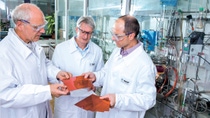
Pigment properties make all the difference
Red, green, and blue: Every pixel contains these three primary colors. The colors are composed of tiny crystals about a thousand times smaller in diameter than a human hair. The crystals act as a filter for the white backlight and only allow light waves from a selected range of the visible spectrum to pass through. These light waves show one of the three colors in its purest possible form. The filters block all the other wavelengths. “A good pigment has a significant impact on the brilliance of the colors the viewer sees,” said Dr. Hans Reichert, head of colorants research at BASF.
“Although perfect color selection is not feasible with absorbing materials, we come fairly close to perfection with our red filters.” Color purity also has an impact on the range of colors available. The greater the purity of the three primary colors, the more permutations that can be achieved by mixing them – and the more colorful the image.
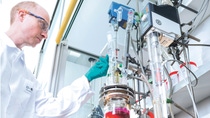
The basic principle is simple. When the color red appears on the screen, the corresponding subpixel lets the red portion of light pass through and absorbs the rest. The other two subpixels – for blue and green – are deactivated when this happens. If, on the other hand, light penetrates through the red and green subpixel while the blue is deactivated, the colors combine to give a rich yellow. Fine-tuning the portions of the three primary colors in this manner produces millions of hues.
The liquid crystals fine-tune the blend of colors by twisting the plane of oscillation of the light waves. “This determines the brightness and color of the subpixels,” said Ger de Keyzer, in charge of applications engineering for color filter materials at BASF. “The liquid crystals change direction, and in that way alter their optical properties depending on the voltage applied.” They rotate the plane of oscillation of light waves to allow the light to pass through the second polarization filter. When an electrical field is applied, however, the crystals prevent some or all of the light from getting through.
To ensure that subpixels switch on and off the way they are supposed to, it is essential to prevent interferences from the color filter pigments. Any interferences resulting in scattering and depolarization of light will allow the light to pass uncontrolled through the filter. This contaminates the colors and compromises the contrast.
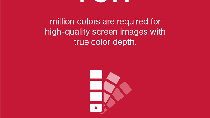

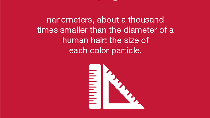
Smaller the better
“A good rule of thumb is: The smaller and more regular the crystals, the lower the scattering and the better the LCD image quality,” de Keyzer said. Researchers control the process mainly by managing the conditions in which pigment crystallization takes place. The underlying molecular structure is what determines which parts of the color spectrum are filtered out.
The organic red pigments that BASF manufactures consist mainly of carbon, nitrogen, and oxygen, and belong to the class of diketopyrrolopyrroles (DPPs). Blue and green pigments are phthalocyanine metal complex compounds. The raw product produced through chemical synthesis is mainly composed of irregular particles. They must then be brought into the ideal size and shape. This is done by a process called pigment finishing. Crystals that are too small are dissolved and precipitated onto the larger crystals. Crystals that are too large are broken into smaller pieces by a mechanical process until the balance is right. Dr. Roman Lenz, BASF lab team leader in charge of new color filter material synthesis, explained: “Our technology gives us color particles of 20 to 40 nanometers – small enough to reduce light scattering to an absolute minimum but large enough to provide a high degree of stability.” BASF has honed the technology almost to perfection with its products. The color particles in the latest generation of the Irgaphor® Red product suite are smaller than 0.00004 millimeters, and have double the contrast performance of their predecessors.
Tomorrow’s television screens will have to meet even higher expectations in terms of resolution and color purity. In anticipation of the new demands, Lenz and his colleagues are taking their lab experiments one step further. Their aim is to find new materials that will show colors in an even more natural light.
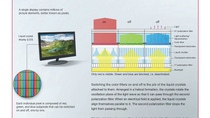

Interview with Dr. Christian Bosshard, President, Thin Film Optics, Swiss Research and Development Center CSEM, Neuchâtel, Switzerland.
Energy efficiency is an important issue with smartphones. How can pigments help liquid crystal display devices to use less power?
The greater the capacity of color filters to cut out a selected part of the color spectrum and let that light pass completely through, the more they will help in cutting electricity consumption. If, say, only 50 percent of the color gets through, more white backlight needs to travel through the pigment to be able to get an intense color experience. Energy consumption rises. Ultimately, energy efficiency is a product of the art of chemistry.
What part does chemistry play, exactly?
The molecules forming the color-filtering crystals need to be distributed such that they absorb exactly the light that they’re supposed to. However, they should not scatter any light, because scattering is one of the ways light gets lost. This means designing nanoparticle synthesis conditions inhibit crystal growth. The smaller and more regular the particles, the less scattering you get. A sphere would be ideal, but you can’t create a sphere with crystals.
What new challenges will the television of the future bring?
The color filter materials for the new 4K TVs are 40 nanometers in diameter, which is already small enough and homogeneous enough to produce high-quality images. Performance expectations will probably be even higher for the next generation of 8K TVs, the first prototypes of which have been unveiled. Still, we have to ask ourselves where the limits are. Improvement in one area often entails deterioration in another. The smaller the color particles, for instance, the less stable they will be. At the end of the day, it’s all about finding the right balance.
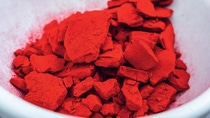
To speak the language of liquid crystal display technology, here are some technical terms you need to know:
The resolution is a measure of image sharpness, based on the total number of pixels. Full HD (high definition) TV screens have a resolution of 1920 x 1080 pixels, or more than two million red, blue, and green pixels.
Liquid crystals are substances that combine some of the properties of liquids and crystals. Their alignment is controlled by electrical fields. Liquid crystals control the color accuracy of the display.
The contrast is the difference between the brightest and darkest possible state of a subpixel. To achieve high contrast, a subpixel needs to be as dark as possible when switched off.
LCD stands for liquid crystal display and is a collective term for liquid crystal displays in devices of all kinds, including watches, TVs, smartphones, and tablets.
LED stands for light-emitting diode. Most LCD televisions on sale today use LED as the white backlight for the screen. Even if the screen is completely black, the backlight still shines.
A light wave is an electromagnetic wave emitted by a light source. It oscillates in all directions.
A pixel is also known as picture element. Pixels are the smallest image elements in displays. They contain red, blue, and green pigments in their subpixels. The more pixels, the sharper and more detailed the image.
A polarization filter only lets light waves through whose electrical field oscillates in a particular direction (polarization).
A subpixel is the smallest possible unit of a liquid crystal display. Each pixel is composed of three subpixels, one for each of the three primary colors – red, blue, and green.
Ultra-HD stands for ultra-high definition. This technology is also known as 4K. Ultra-HD devices deliver four times more pixels than HD displays – about eight million.

